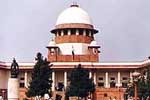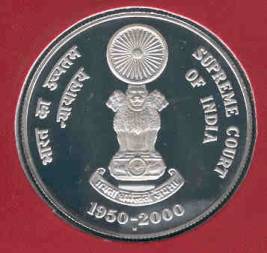 |
 |
 |
 |
 |
 |
 |
 |
 |
 |
 |
 |
 |
 |
 |
 |
 |
 |
 |
 |
 |
 |
 |
 |
 |
 |
 |
 |
 |
 |
 |
 |
 |
 |
 |
|
|
Golden Jubilee of Supreme Court of India |
|
|
|
 |
|
|
|
India's commitment to law is created in the Constitution which constituted India into a Sovereign Democratic Republic, containing a federal system with Parliamentary form of Government in the Union and the States, an independent judiciary, guaranteed Fundamental Rights and Directive Principles of State Policy containing objectives which though not enforceable in law are fundamental to the governance of the nation. |
|
|
|
ENACTMENT OF LAWS |
|
|
|
The fountain source of law in India is the Constitution which, in turn, gives due recognition to statutes, case law and customary law consistent with its dispensations. The Indian Parliament is competent to make laws on matters enumerated in the Union List. State Legislatures are competent to make laws on matters enumerated in the State List. While both the Union and the States have power to legislate on matters enumerated in the Concurrent List, only Parliament has power to make laws on matters not included in the State List or the Concurrent List. |
|
|
|
JUDICIARY |
|
|
|
One of the unique features of the Indian Constitution is that, notwithstanding the adoption of a federal system and existence of Central Acts and State Acts in their respective spheres, it has generally provided for a single integrated system of Courts to administer both Union and State laws. At the apex of the entire judicial system, exists the Supreme Court of India below which are the High Courts in each State or group of States. Below the High Courts lies a hierarchy of Subordinate Courts. Panchayat Courts also function in some States under various names like NyayaPanchayat, PanchayatAdalat, Gram Kachheri, etc. to decide civil and criminal disputes of petty and local nature. |
|
|
|
CONSTITUTION OF SUPREME COURT |
|
|
|
On the 28th of January, 1950, two days after India became a Sovereign Democratic Republic, the Supreme Court came into being. The inauguration took place in the Chamber of Princes in the Parliament building which also housed India's Parliament, consisting of the Council of States and the House of the People. |
|
|
|
 |
|
The original Constitution of 1950 envisaged a Supreme Court with a Chief Justice and 7 puisne Judges - leaving it to Parliament to increase this number. As the number of the Judges has increased, they sit in smaller Benches of two and three - coming together in larger Benches of 5 and more only when required to do so or to settle a difference of opinion or controversy. The Supreme Court of India comprises the Chief Justice and not more than 25 other Judges appointed by the President of India. Supreme Court Judges retire upon attaining the age of 65 years. |
|
|
|
|
|
The Constitution seeks to ensure the independence of Supreme Court Judges in various ways. A Judge of the Supreme Court cannot be removed from office except by an order of the President passed after an address in each House of Parliament supported by a majority of the total membership of that House and by a majority of not less than two-thirds of members present and voting, and presented to the President in the same Session for such removal on the ground of proved misbehaviour or incapacity. A person who has been a Judge of the Supreme Court is debarred from practising in any court of law or before any other authority in India. |
|
|
|
Coins on Golden Jubilee of Supreme Court of India |
|
|
|
 |
|
|
|
 |
|
|
|
Face of 50 Rs Coin |
|
Face of 2 Rs Coin |
|
|
|
On the occasion of Golden Jubilee of Supreme Court, GOI issued special coins in the denomination of 2 Rs & 50 Rs in 2000. 50 rs coin in circular in shape. 2 Rs coin is eleven sided. |
|
|
|
Main Page |
|
|
|
Acknowledgement: Web site of Hon Supreme Court of India |
|







